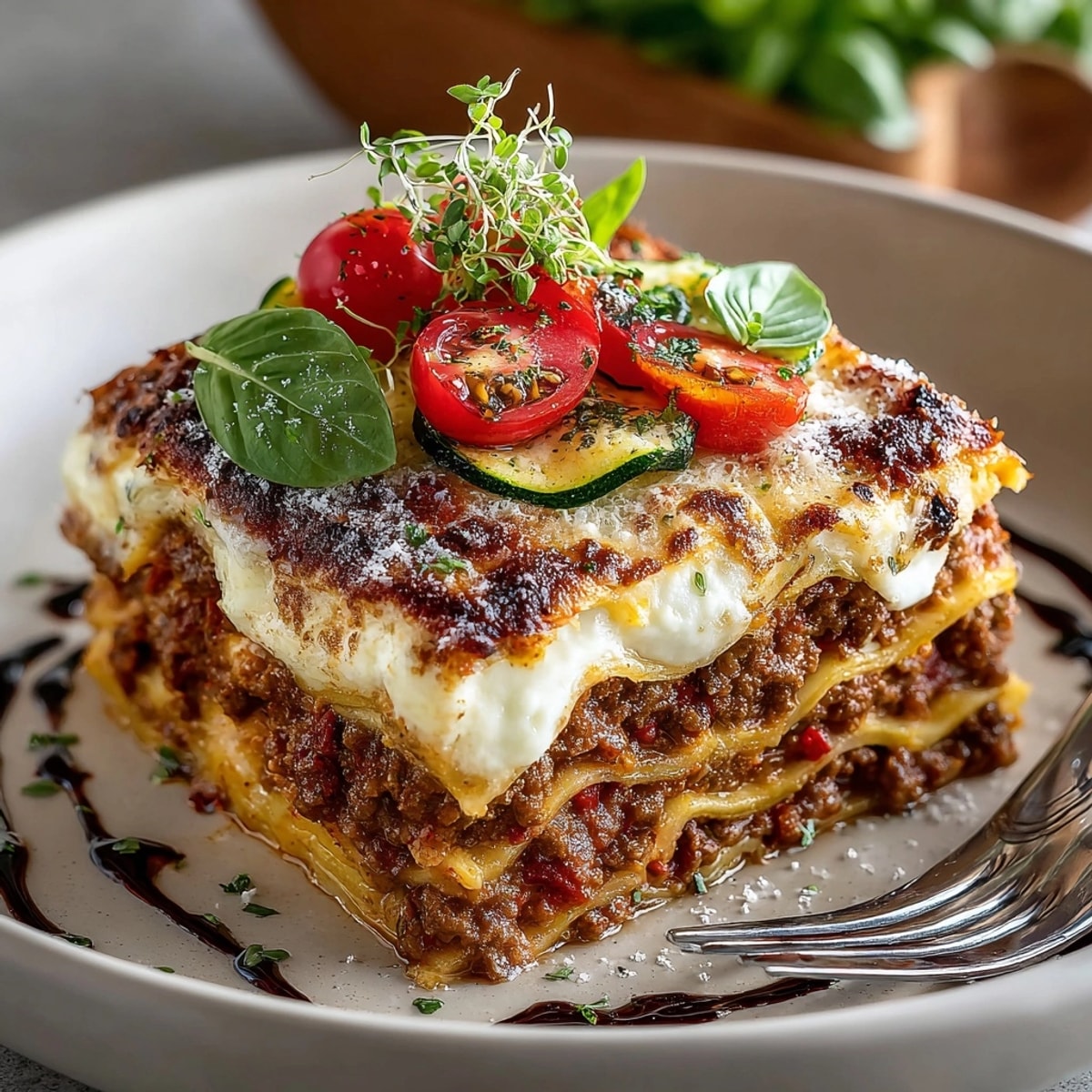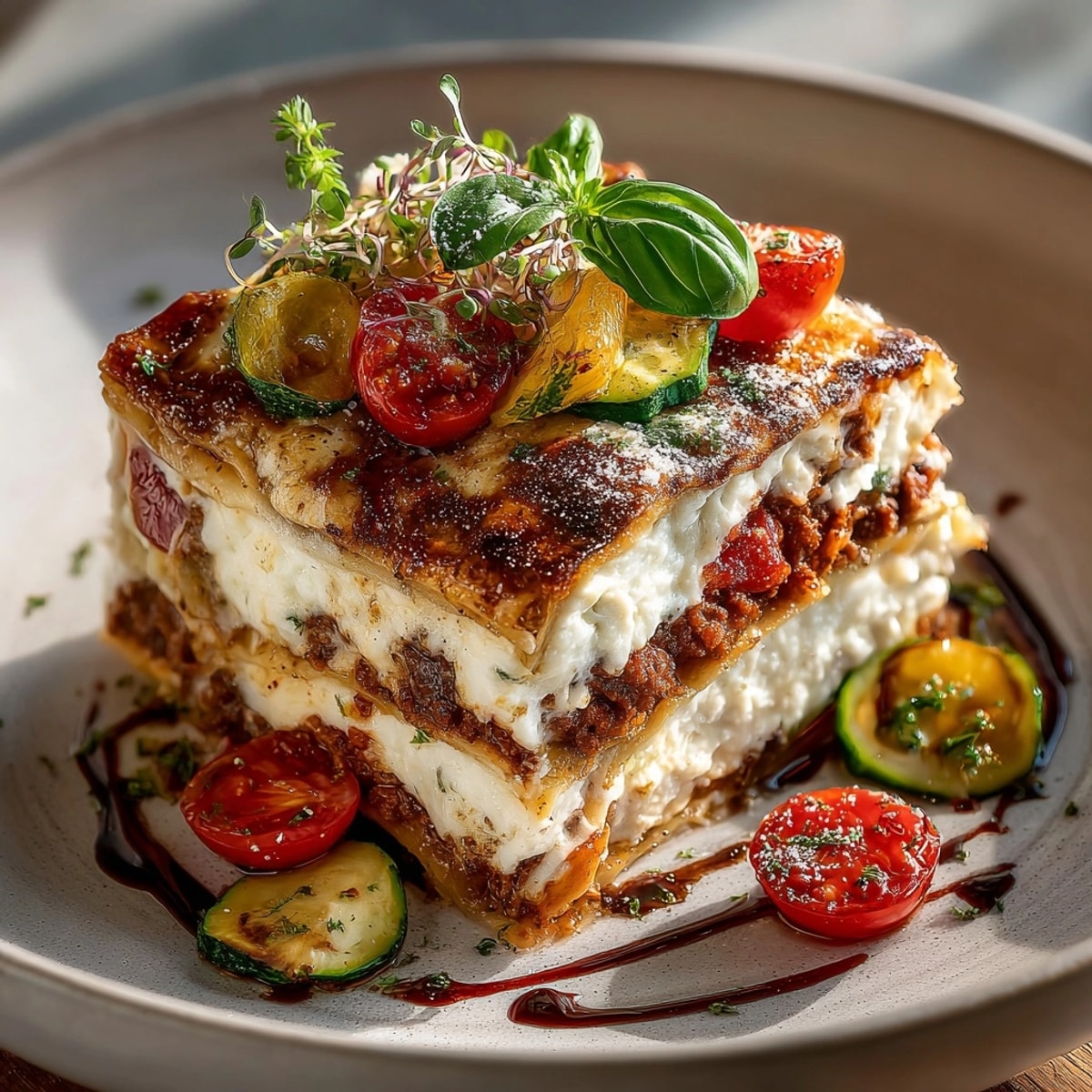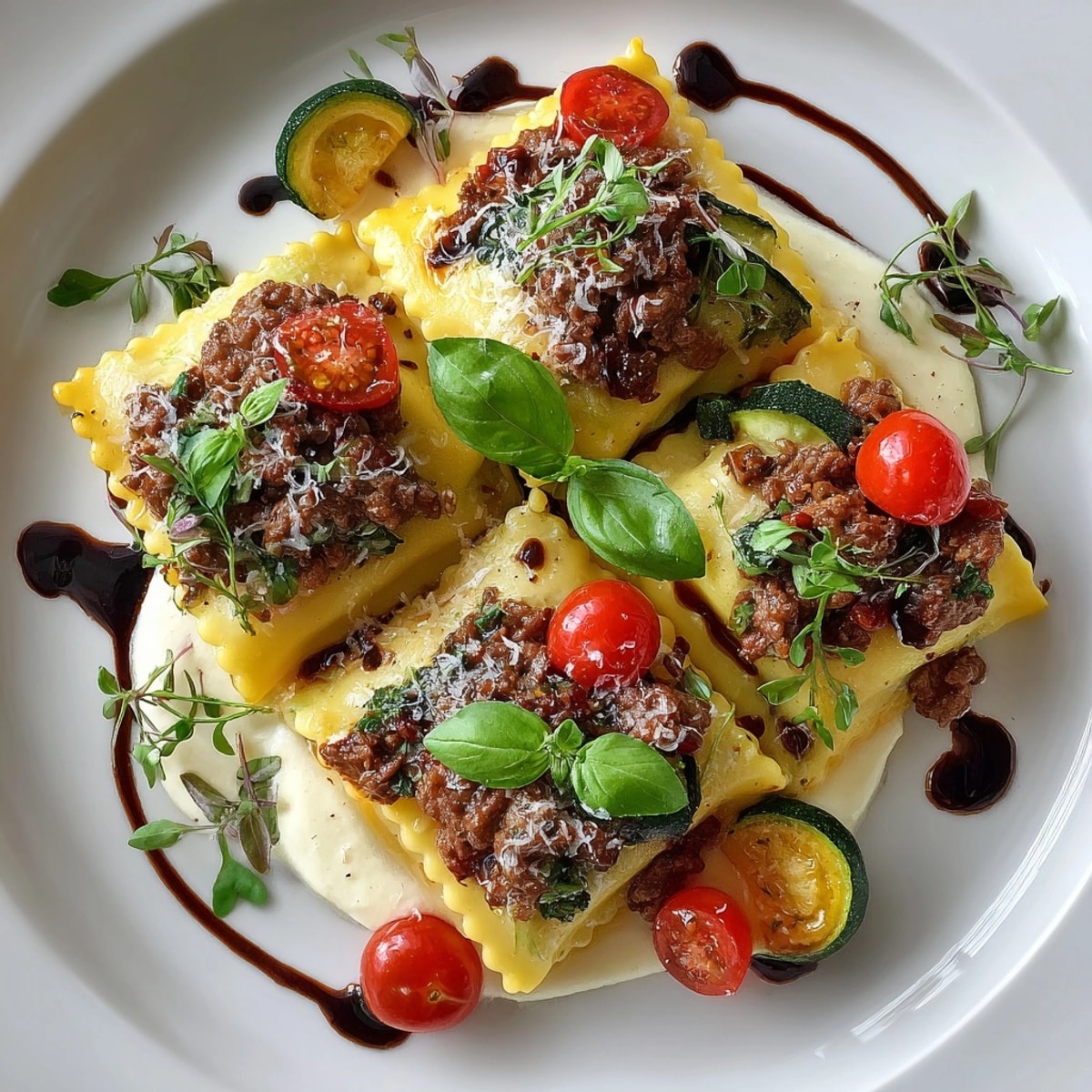 Save
Save This deconstructed lasagna transforms a humble family dish into an elegant culinary presentation worthy of fine dining. By separating traditional lasagna components and arranging them artfully on the plate, you'll create a memorable dining experience that celebrates each flavor individually while honoring the classic combination.
I first created this recipe when hosting an anniversary dinner for my parents who adore traditional lasagna. The delight on their faces seeing their favorite comfort food reimagined was priceless, and now it's become our signature dish for celebrations.
Ingredients
- Fresh lasagna pasta sheets: provide the ideal canvas for this presentation. Choose egg pasta for richness and suppleness
- Ground beef and pork combination: creates a perfectly balanced ragù with ideal fat content and flavor complexity
- Crushed tomatoes: offer better texture than puree. Look for San Marzano variety for authentic Italian flavor
- Parmigiano Reggiano aged 24 months: provides the perfect umami punch. Accept no substitutes for this crucial component
- Whole milk: creates silky béchamel. Avoid reduced fat options which produce inferior sauce texture
- Fresh basil and microgreens: add vibrant color and aromatic freshness to complete the visual presentation
Instructions
- Create the Perfect Ragù:
- Begin by heating olive oil in a heavy-bottomed saucepan over medium heat until it shimmers slightly. Add your finely diced mirepoix of onion, garlic, carrot and celery, stirring frequently until vegetables soften and become translucent but not browned, about 5 minutes. This aromatic base builds the foundation of flavor for your entire dish.
- Brown the Meat Properly:
- Add both ground meats to the softened vegetables, breaking apart with a wooden spoon to ensure no large clumps remain. Allow the meat to cook until it loses its pink color and begins to brown slightly at the edges, developing crucial flavor compounds. Stir in tomato paste and cook for a full minute to caramelize its sugars and remove any metallic taste.
- Develop Complex Flavor:
- Pour in your red wine and increase heat slightly, allowing alcohol to evaporate while stirring occasionally. The wine should reduce by half before adding crushed tomatoes, herbs, and seasonings. Reduce heat to maintain a gentle simmer and cook uncovered for the full 45 minutes, stirring occasionally to prevent scorching. This slow cooking develops the rich, complex flavor that distinguishes an exceptional ragù.
- Master the Béchamel:
- For perfect béchamel, melt butter completely over medium heat before adding flour all at once. Whisk continuously for 1-2 minutes until mixture smells slightly nutty but remains pale in color. This crucial step cooks out the raw flour taste. Add warmed milk in small increments at first, whisking vigorously to prevent lumps, then in larger amounts as sauce begins to form. Continue cooking until sauce coats the back of a spoon and holds a line when you run your finger through it.
- Prepare Pasta Properly:
- Whether using fresh or dried pasta, timing is crucial. Fresh pasta needs just 60-90 seconds in rapidly boiling salted water before transferring to an oiled tray to prevent sticking. For dried pasta, cook until just shy of al dente as it will continue absorbing moisture. Handle gently to maintain structural integrity for plating.
- Plate with Artistic Intention:
- Approach plating as an artist would a canvas. Begin by placing pasta sheets strategically, creating height and dimension. Apply ragù and béchamel in distinct areas rather than mixing, using the back of a spoon to create elegant swooshes or quenelles. Position vegetables and garnishes thoughtfully, considering color contrast and visual balance. Finish with a restrained drizzle of balsamic glaze and a light dusting of finely grated Parmigiano Reggiano.
 Save
Save My favorite element is the contrast between the silky béchamel and the robust ragù. I learned this technique during a cooking workshop in Bologna, where our instructor insisted that experiencing each component separately before combining them creates a more profound appreciation for the dish as a whole.
Make-Ahead Options
This deconstructed lasagna is ideal for entertaining because nearly every component can be prepared ahead of time. The ragù actually improves with a day of rest in the refrigerator, allowing flavors to meld and develop complexity. Prepare it up to three days ahead and gently reheat before serving. Béchamel sauce can be made the day before and stored with plastic wrap pressed directly onto its surface to prevent skin formation. When ready to use, warm gently while whisking to restore its silky texture.
Fresh pasta can be made and cut into sheets a day ahead, layered between parchment and refrigerated. If using dried pasta, cook it just before serving for optimal texture. Vegetables can be prepped earlier in the day but should be sautéed just before plating to maintain their vibrant appearance and texture.
Customization Ideas
The beauty of component plating is the endless opportunity for personalization. For a seafood variation, replace the meat ragù with a delicate sauce of shrimp, scallops and white wine. Vegetarians will appreciate a wild mushroom and truffle ragù with roasted butternut squash. During summer months, consider a fresh tomato and basil sauce with burrata instead of béchamel.
The pasta itself offers another canvas for creativity. Incorporate spinach or beet puree into your pasta dough for striking color contrasts. Cut pasta into interesting geometric shapes rather than traditional rectangles for modern visual appeal. For special occasions, consider using squid ink pasta for dramatic black sheets against the colorful components.
Wine Pairing Suggestions
This elegant presentation deserves thoughtful wine pairing. A medium-bodied Sangiovese-based wine like Chianti Classico offers bright acidity to cut through the richness of the ragù and béchamel while complementing the tomato notes. For white wine enthusiasts, consider an oak-aged Vernaccia di San Gimignano with enough body to stand up to the dish while providing refreshing contrast.
For special occasions, splurge on a Brunello di Montalcino with a few years of age, whose complex tertiary notes will echo the depth of your slow-simmered ragù. If serving as part of a multi-course meal, align your wine progression accordingly, perhaps starting with a crisp Vermentino if this is served as a middle course.
Cultural Context
This deconstructed approach represents the evolution of Italian cuisine in modern fine dining. Traditional lasagna originated in Naples during the Middle Ages before becoming standardized in Bologna with ragù and béchamel. This contemporary interpretation honors those traditions while embracing modern culinary aesthetics.
The component plating technique emerged from the molecular gastronomy movement of the early 2000s, where chefs began deconstructing familiar dishes to highlight individual elements and create new textural experiences. While respecting classical technique and authentic flavors, this presentation style invites diners to appreciate each element individually before experiencing them in combination.
 Save
Save Elevate your next dinner party with this stunning deconstructed lasagna, offering a modern take on a beloved classic. The artful presentation and distinct flavors create a sophisticated dining experience that is sure to impress.
Recipe FAQ Section
- → How do I achieve clean, artistic plating?
Arrange pasta sheets and sauces with food rings or plating tweezers, leaving negative space. Add vegetables and garnishes last for visual appeal.
- → Can I use dried pasta sheets?
Yes, cook dried lasagna sheets until al dente, then brush with olive oil to prevent sticking before plating.
- → What’s the best sauce consistency for this dish?
Both ragù and béchamel should be thick enough to hold their shape on the plate, ensuring neat, artistic pools.
- → Can I make this lasagna vegetarian?
Substitute the meat ragù with a mushroom-lentil mixture for a satisfying, plant-based take on the dish.
- → How do I enhance flavors with garnishes?
Add fresh basil, microgreens, and a drizzle of balsamic glaze just before serving for freshness and depth.
- → What wine pairs well with this meal?
A medium-bodied Italian red, like Chianti, complements the savory ragù and creamy béchamel perfectly.